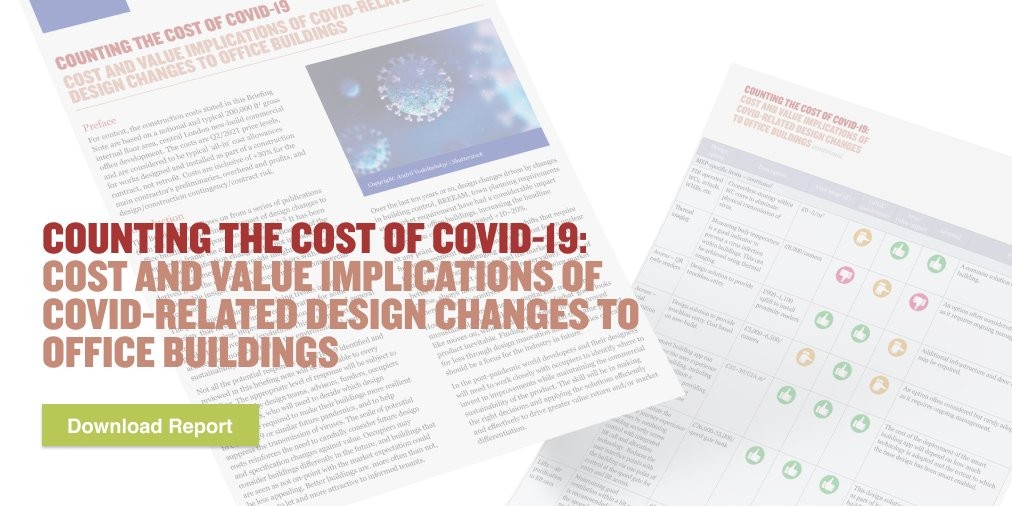
BCO Voices - Counting the Cost of Covid
New standards for the post-COVID office – but at what cost?
#BCOVoices
The COVID-19 pandemic has been a great challenge for the office, but while this difficult period has disrupted the working lives and routines of many, it has also given us the opportunity to re-think the office environment – not just in terms of safety, but also its quality and appeal.
We must of course consider the risks of COVID, but as we return to the workplace, the office must, perhaps more so than ever, be a place that encourages collaborative work and social interactions for those who have missed out on proximity to colleagues while working from home. It must also keep up with the ever-important environmental and sustainability agenda, and ‘greener’ building innovations, which more office users and stakeholders want to see.
To accommodate this, we’re seeing more offices invest in innovative solutions and design-changes – some more drastically than others. It’s important to understand that not all solutions will be applicable to every building. With the varying costs of some of the design changes we’ve seen in recent months, building owners and developers must carefully consider their necessity in terms of their future requirements, and what impact these may have on the space’s overall value.
This is something we explored in the British Council for Offices’ (BCO) latest report ‘Counting the Cost of Covid-19’ which examines the cost of various design options witnessed across the sector, as well as their impact on value.
So which areas are seeing most innovation, and what are the main considerations for investors?
As offices consider solutions to improve their resilience to COVID-19, we’re seeing more investments in solutions that improve ventilation and access to outdoor air within offices – from fully upgraded ventilation systems, to natural ventilation solutions, or more affordable air quality monitoring technology deployed in conjunction with existing systems.
We’re also seeing how technology can help provide a safer working environment, as some offices deploy options that allow touchless journeys throughout the office, such as motorised doors, facial recognition enabled access or automated lift allocation. But for many, a more cost-effective approach to reducing the risk of virus transmission through touch, might be found in incorporating more hygienic building materials into building designs, with anti-bacterial treatments and non-porous surfaces that enable ease of sanitisation.
Beyond COVID, the pressing environmental and sustainability agenda is driving ‘greener’ building innovations, such as natural ventilation systems like opening and breathable façades and the installation of charging points for e-bikes and scooters. Another approach to supporting more sustainable behaviours which we’ve seen in offices, is investment in amenities for active commuting, such as showers, changing and storage facilities.
As demand from occupiers looking for the right space remains high post-COVID, we must consider what the right offering may look like in future for a given office to remain attractive to the market. In other words, a building designed with COVID-safety or sustainability in mind tends to let faster, therefore providing a commercial benefit. However, BCO experts understand that, as with any investment in design changes, it’s important to carefully consider how valuable each solution will be to each space, as this will vary depending upon the type of building, or its expected occupancy post-COVID as more people come to adopt a hybrid working style.
Even before the pandemic, the office was constantly evolving to meet changing behaviours and preferences across the market. As we consider how we will occupy and work from our offices in years to come, now is the perfect time to innovate and plan for meeting future demand.
I am personally looking forward to seeing some of the industry’s most recent ideas as part of the upcoming British Council for Offices’ 2022 Awards. Entries are still open - if you have a project that was completed between 1st January 2017 and 1st November 2021, then it is eligible to be entered into the competition.
Chief Marketing Officer | Product MVP Expert | In Dubai from 21st Till 27th March GISEC WTC
4moMark, thanks for sharing!
Managing Director Inside Limited, Fit Out, Construction, Refurbishment, Engineering
2yThe collaboration spaces are great however I can see the need for more booth type areas as more of us are on Teams calls now and so acoustic separation is becoming a key design factor. I am glad venting buildings properly is becoming a higher priority.